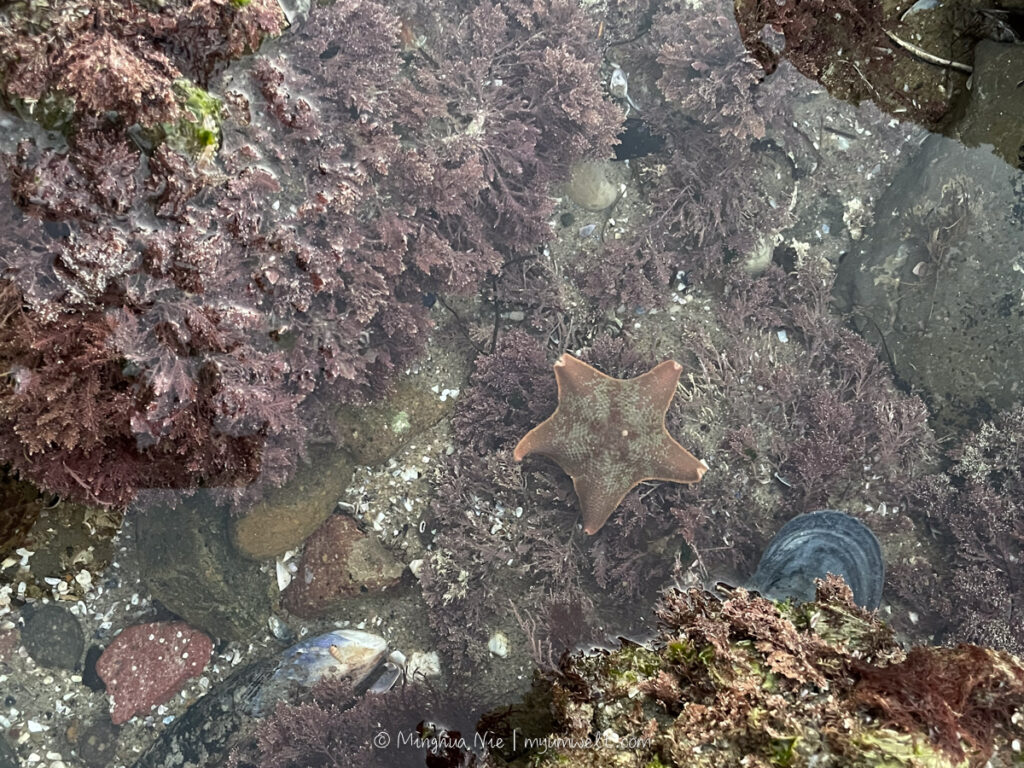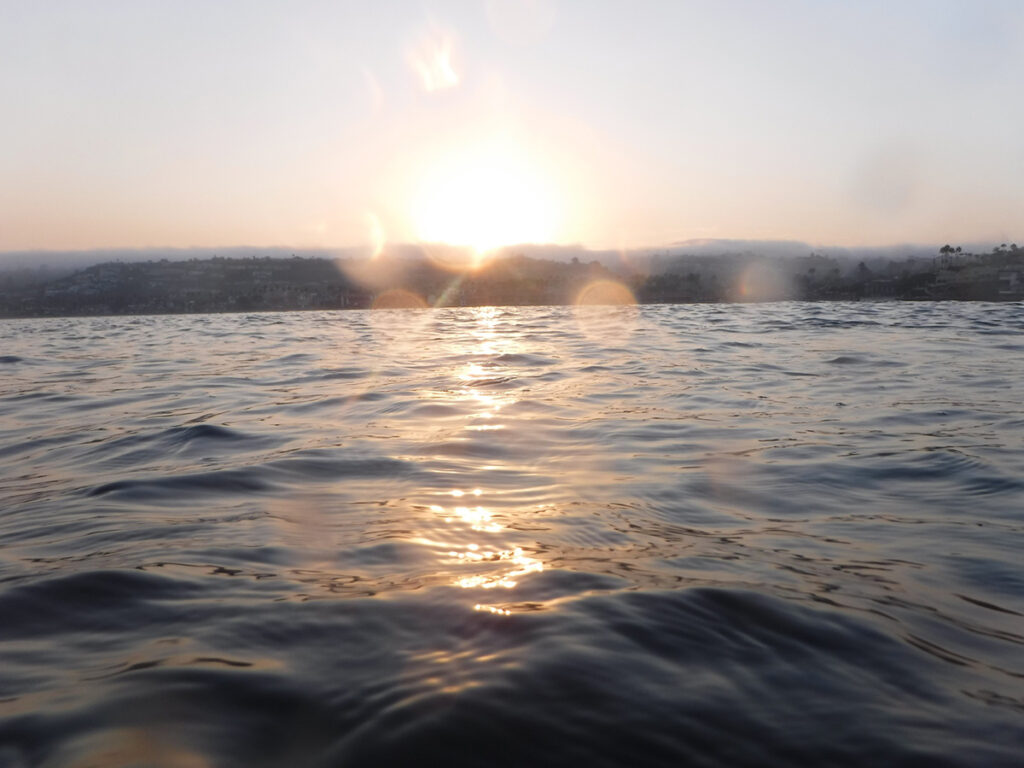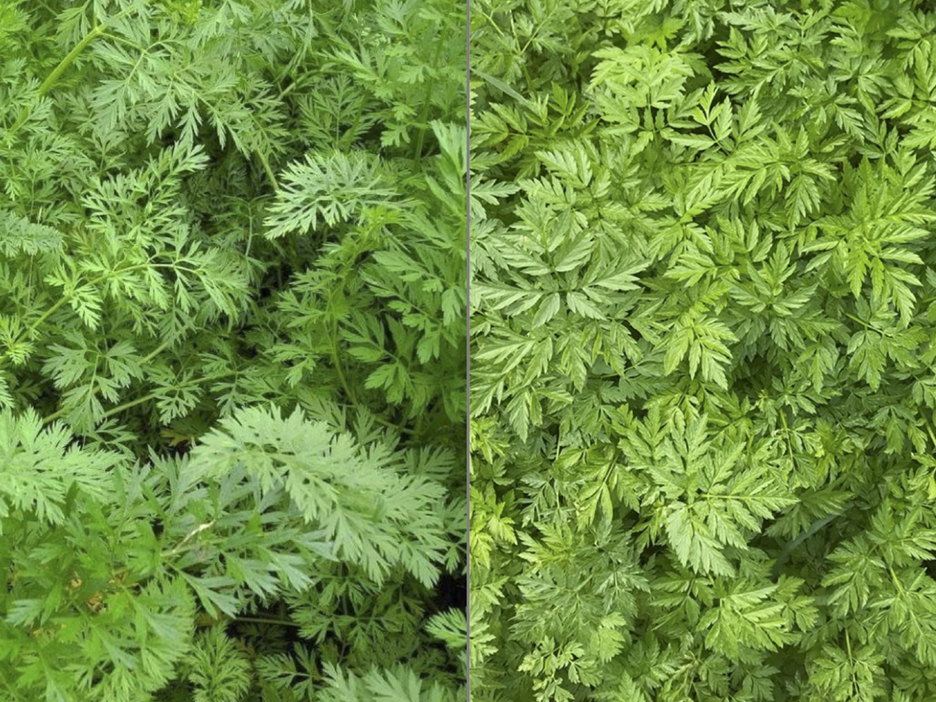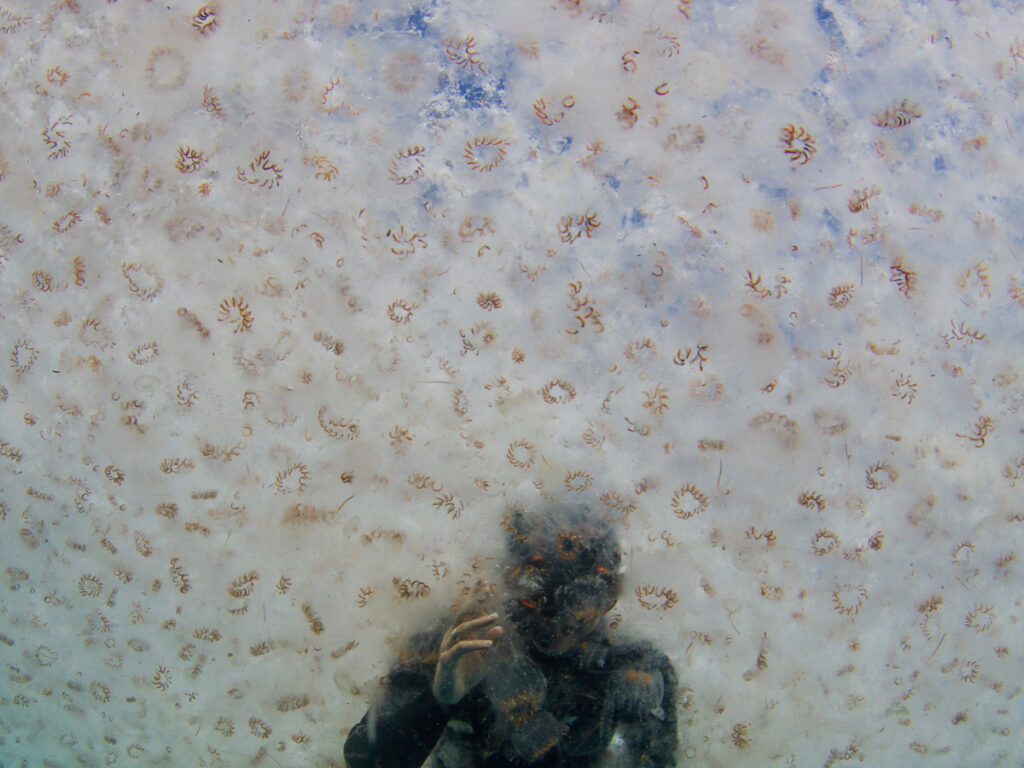
What are some of the superpowers you’d dream of: Invisibility? Transformation? Lightning speed? An army of clones? What would you do, if you were to meet such a someone with all these superpowers? I met such a someone one summer morning.
I’ve been swimming regularly in the Pacific Ocean off La Jolla Shores since 2018. On July 11th, 2022, I started my swim with two friends at 6AM. Midway through, something unusual caught my eye—something looking like clear Jell-O pieces were drifting toward me, past me. Without a pause, I swam on, feeling disgusted.
“So much plastic pollution!” I decided on their identity by pure instinct.
As more began to come, the more detail I began to discern. They were not just clear Jell-Os—many contained an orange-colored, pea-sized core. Like little packs of candy sold at H-Mart, I thought. But I knew they were not candy. “Ghost fish!” I decided on another name.
At a buoy about 1000 meters west of La Jolla Shores, I caught up with my friends. I learned that they too had noticed and puzzled over the “Jell-Os.” In just minutes while we were resting and chatting, we were surrounded. Amazed, we held our breath to watch them below the ocean surface. They were about the size of a quarter. Some joined to form chains. Were they jellyfish? Would they sting? We wiggled our bodies out of the way to avoid touching them but felt no sting by the inevitable contact. My curiosity soon overtook my fear; I picked some up. Soft and squishy, the crystal bracelet-like chain I held was made up of identical units, each with an orange “pit.” The units broke apart easily, even with careful handling. While checking out these strange things, we had drifted afar from the buoy. An uncommon strong eastbound current that day brought us some uncommon visitors.
Back on land, I learned from another swimmer who had seen them on the East Coast: they were salps.
The Invisible Blobs
“No one ever looked at something beautiful and named it salp.”
Several Septembers ago, Sabrina Imbler saw “shimmering heaps of gelatinous blobs strand on the shores of Riis Beach (Long Island),” even “swam with the blobs” in the unsinkable Jell-O-y water. “They looked like raindrops, or tears, water in a state of falling,” she recalled in her book How Far the Light Reaches. What were they? She Googled “clear gelatinous lumps on the beach no sting,” but found no reports of them in the news. For years those transparent blobs seemed to only exist in her memory—their identity remains unconfirmed.
Had no one told me my “plastic/Jell-O/ghost fish” were salps, I too probably would have struggled with solving the mystery of the strange blobs. I Googled “salp” and found photos and descriptions matched well with what I had seen and touched.
Salp, or Salpa, comes from the Ancient Greek “σάλπη”—fish. But salps are not fish. They are pelagic gelatinous zooplanktons, which also include jellyfish. Salps are commonly confused with jellyfish, even though their ancestries diverged over 800 million years ago. “The only thing salps and jellyfish have in common is that both are gelatinous, and both float around in the ocean,” says Larry Madin, former executive vice president and director of research at the Woods Hole Oceanographic Institution (WHOI) in Massachusetts. Jellyfish are in the phylum Cnidaria, which all have signature, explosive, toxin-firing cells—cnidocytes—to paralyze their prey. Salps belong to the phylum Chordata and have proto spines, which put them as the closest invertebrate cousins to humans. Evolutionarily, jellyfish are far more alien to us. However, jellyfish sting and salps don’t. Being harmless does not help salps to get attention.
Drifting freely in all open oceans except for the Arctic, salps are ephemeral visitors of the human world, when some are carried some ashore by currents, jamming up beaches or the intakes of nuclear power plants. They catch our attention briefly. They are greeted with surprise or bewilderment—they have been called “alien,” “jelly-balls,” “globs,” or “buckets of snot.” Their fleeting visits are just as quickly forgotten.
On that swim I scooped up a few salps and put them inside my swim cap, to take home to show my daughter. The schools were closed in 2020 during the COVID-19 pandemic, so we homeschooled her during her second-grade year and bought a few used scientific instruments to enrich her home education. Together, we looked at butterfly wings found in our backyard, stinging nettle leaves plucked from trails in our neighborhood, rocks picked up on our hikes, even sand grains from La Jolla Shores beach. Unfortunately, the soft, squishy bodies of my salps did not survive a trip in a cap. Under the microscope, besides the orange “cores,” they lacked any features and looked totally unremarkable. My daughter did not care for a second look. My samples quickly turned into a puddle of smelly goop.
Seeing Salps
“a meticulous scientist with the soul of an artist”
Salps are 95% water; their watery bodies often seem too featureless to be capitulated visually. Early observers of salps created illustrations with extraordinary anatomical accuracy; yet their drawings and watercolor paintings could not faithfully capture live salp’s ethereal transparency. On paper, the illustrated animals are opaque, looking more like their pickled specimen.

When Larry Madin was an undergraduate at UC Berkeley, he once peered into a glass jar and saw some strange, preserved creatures he had never seen before; he was intrigued. His teacher didn’t know what they were. Madin later found out that they were salps, and not many people knew about them. He decided to study them as a graduate student at UC Davis and later as a faculty at WHOI, where he worked for forty-five years. He turned his fascination with ocean gelatinous plankton into a lifelong passion and research career.
Madin developed techniques to present delicate marine gelatinous plankton, like salps, the way they are in their aquatic home. While studying at UC Davis under William Hamner, Madin found his way back to the ocean. Madin, Hamner, and other graduate students of Hamner pioneered bluewater SCUBA diving and using marine submersibles to study ocean plankton: techniques now widely used in marine biology. They invented tethered scuba diving—a groundbreaking method for scientific research and discovered many new species of gelatinous marine life. Madin also developed new lighting techniques to help him capture spectacular images of elusive jellyfish, siphonophores, and other gelatinous creatures.
How to photograph “water in a state of falling”—in water?! Madin’s secret is briefly revealed in a WHOI video tribute to celebrating his life achievement: Donning a hefty diving suit and holding a bulky large camera equipped with a specially mounted flash, Madin was drifting alongside a barely visible, continuously morphing blob, down toward the ocean abyss—a mesmerizing scene that feels extraterrestrial.
The salps Madin photographed are textbook beautiful. Salps, also known as tunicates in the subphylum Tunicata, have tunic-shaped bodies. In a photo he took of a Salpa thompsoni, I see something that reminds me of that summer ocean encounter: reflection of strobe light outlines a tubular body barely discernible from the inky dark background; a few hair-thin white lines hint ring-like structures circling along the tube; an orange spot is conspicuous; and (something I did not see on my swim) a long pearly white ribbon extrudes from and extends beyond the clear body. The photo also reveals more intriguing details: a few tiny, orange-colored Crustaceans roaming around inside the salp’s clear body, like fish food in a plastic bag. The rest of the salp is not visible—the salp’s other organs are completely watery clear.
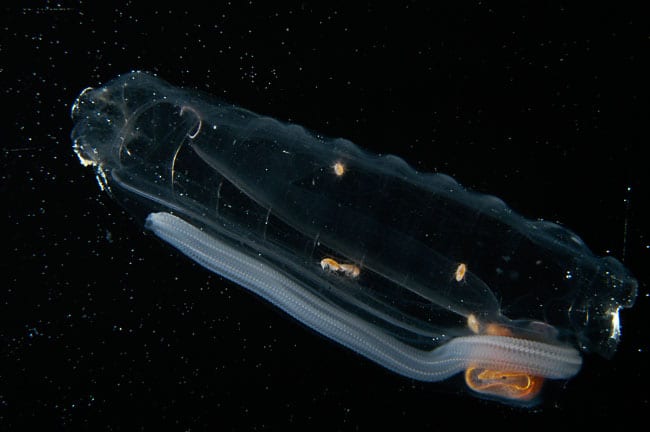
The almost imperceptibly thin rings are muscle bands that contract along a salp’s body to squeeze it like a water balloon. The coordinated contraction and relaxation of the muscles siphon water into one end of the tube and push out the other, serving both as a food pump and a motor. By squirting water, or jet propulsion, salps can move a full body length every few seconds: the pace of human Olympian swimmers.
The salp in Madin’s photo is an adult salp of the solitary generation, giving birth to the salps in the next, aggregate generation—the pearly ribbon extruding from the adult is a chain of its clonal offspring. Long before salps were recorded in the field of science, they were known to the men at sea: Norwegian fishermen called them “korleband (necklace)” or “silderaeke (row of herrings)”. What they saw and what I picked up on my swim were salps in the aggregate generation. Over two hundred fifty years ago, Patrick Browne first entered salps in the scientific record in his 1756 book The Civil and Natural History of Jamaica. He understood then that salps exist in both solitary and aggregate forms.
A solitary salp, or an oozooid, reproduces asexually. It makes a chain of tens to hundreds of interconnected clones, called blastozoids (the pearly white long ribbon in Madin’s photo). Salp chains can take on the shape of spirals, helices, or rosettes, depending on the species. While remaining strung together, until broken by force, the chain of blastozoids can grow from a few centimeters to 10 meters long. The blastozoids reproduce sexually, each nursing an embryo that will grow up into a solitary oozooid. Cycle thus goes on; and likeness skips generation.
Few know that salps contributed to human’s first understanding of metagenesis—alternation of generations—in animals. German writer Adelbert von Chamisso discovered that the salps previously described as different species were two generations of the same species, when he worked as a naturalist on board the Russian brig Rurik from 1815 to 18181. We now know that alternation of generations is a common strategy in nature for coping with sudden, drastic environmental changes. When Chamisso proposed this idea, it was so new that most scientists at the time denied or even ridiculed it. It took the scientific world over twenty years to confirm and accept this remarkable insight. Chamisso’s role in this finding is largely forgotten. To date, Chamisso is better remembered as a poet and a botanist. Several California native plants, such as Mojave suncup (Camissonia brevipes) have been named in his honor. Next time I catch the sight of cheerful bright yellow faces of suncups dancing in Mojave Desert wind, I will think of salps.
Madin has been called “a meticulous scientist with the soul of an artist”—a trait shared by other naturalists who set their eyes upon salps’ seemingly featureless clear body. In Chamisso’s watercolor drawings of salps, all prominent features are clearly illustrated. He probably had the help of “Weingeist” (strong alcohol) to reveal additional features. Preservatives turn some of the clear body parts opaque by denaturing proteins, similar to egg white turns white once cooked. Salp’s transparency allows some internal processes to be seen without dissection. Charles Darwin was one of the first to make accurate physiological observations of salps he collected while on board H.M.S. Beagle. He noted their regular pulsation (19 beats in 30 s) and the rapid circulation of the blood in the gill bar.
Thomas Huxley made salient contributions to understanding salp biology by discovering a novel organ—endostyle2. In his two 1851 articles, Huxley wrote detailed descriptions of anatomy of salps and other tunicates, calling endostyle a “very remarkable distinctive character of the Tunicata.” Endostyle, that faint, light gray band running diagonally from front to back of the salp in Madin’s photo, is a vital organ that filters and traps food. In 2010, Larry Madin and Kelly Sutherland looked at endostyle much more closely3. They attached endostyles from living salps onto very thin pieces of glass (coverslips) and stained them. Looking through a high-power microscope, they saw a mucous-covered fine net of mesh, nanometers in thickness. Endostyle works like an internal sticky plankton net that catches food widely different in sizes: from microscopic bacteria smaller than the holes of this net to large plankton visible in Madin’s photo. Salps are so efficient in collecting food, they have been called the “ocean’s vacuum cleaners.”
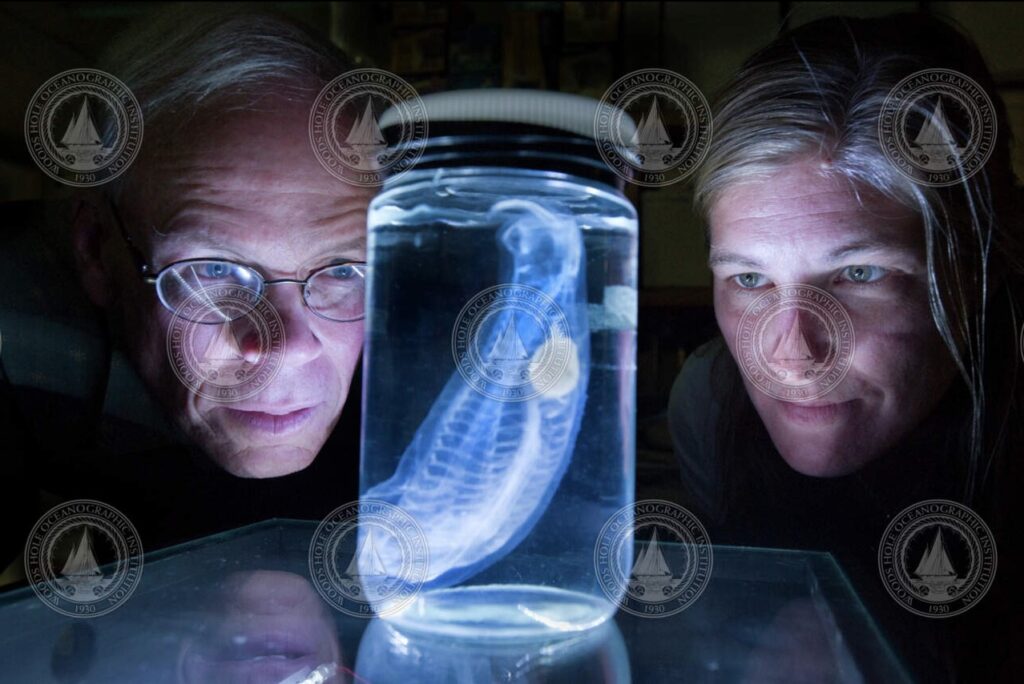
Turbo-powered with engines for survival, growth, and reproduction, salps can bloom to billions even trillions when the wind blows right.
References:
- Matthias Glaubrecht, and Wolfgang Dohle. “Discovering the Alternation of Generations in Salps (Tunicata, Thaliacea): Adelbert von Chamisso’s Dissertation “de Salpa” 1819 – Its Material, Origin and Reception in the Early Nineteenth Century.” Zoosystematics and Evolution, vol. 88, no. 2, 1 Oct. 2012, pp. 317–363, https://doi.org/10.1002/zoos.201200024.
- Lemaire, Patrick, and Jacques Piette. “Tunicates: Exploring the Sea Shores and Roaming the Open Ocean. A Tribute to Thomas Huxley.” Open Biology, vol. 5, no. 6, June 2015, p. 150053, https://doi.org/10.1098/rsob.150053.
- Sutherland, Kelly R., et al. “Filtration of Submicrometer Particles by Pelagic Tunicates.” Proceedings of the National Academy of Sciences, vol. 107, no. 34, 24 Aug. 2010, pp. 15129–15134, www.pnas.org/content/107/34/15129, https://doi.org/10.1073/pnas.1003599107.
Notes:
- Thanks to my friends Belinda Little and Sussi Yamaguchi for being on that July 2022 swim with me, and to Michelle Marquez for telling me the creatures were salps.
- Last update on June 3, 2024

